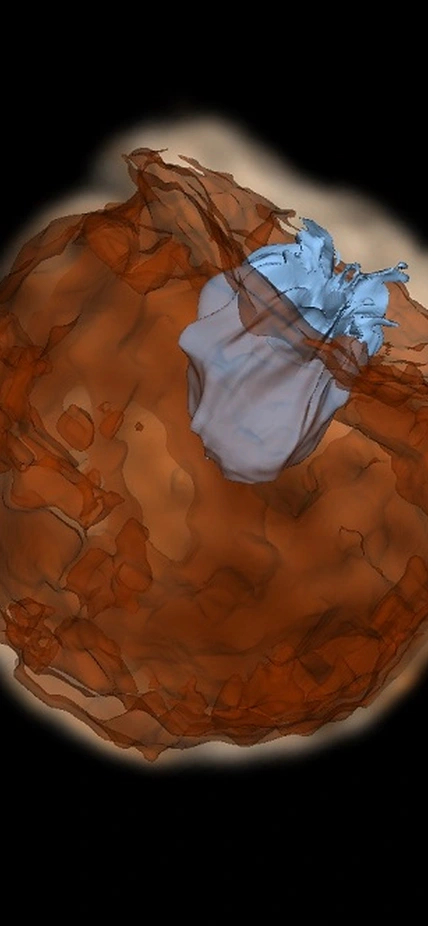Pasadena, CA— Type Ia supernovae are violent stellar explosions that shine as some of the brightest objects in the universe. But there are still many mysteries surrounding their origin—what kind of star system they originate in and how the explosions begin. New work from the intermediate Palomar Transient Factory team of astronomers, including Carnegie’s Mansi Kasliwal, provides strong evidence pointing toward one origin theory, called the single degenerate channel. This work is published May 21 by Nature.
Type Ia supernovae are commonly theorized to be the thermonuclear explosions of a white dwarf star that is part of a binary system—two stars that are physically close and orbit around a common center of mass. But how this white dwarf goes from binary star system to type Ia supernova is a matter of debate.
The single degenerate channel theory hypothesizes that the white dwarf accretes matter from its companion star and the resulting increase in its central pressure and temperature reaches a tipping point and ignites a thermonuclear explosion. In contrast, the double degenerate theory proposes that the orbit between two white dwarf stars shrinks until the lighter star’s path is disrupted and it moves close enough for some of its matter to be absorbed into the primary white dwarf and initiate an explosion.
Last May, the iPTF team observed an explosion in the vicinity of a galaxy called IC 831, where no such activity had been seen previously, even the very night before. They called it iPTF14atg. Follow-up observations confirmed that this was indeed a type Ia supernova, one which ignited between May 2 and May 3.
Looking at the event from Swift space telescope observation records, the team detected bright ultraviolet emission from the new supernova.
"I was examining the first Swift images when suddenly I saw a bright spot at the location of the supernova in the ultraviolet. I jumped up because I knew it was the signature that I had been hoping for," said Caltech graduate student Yi Cao, lead author of the paper.
Because ultraviolet radiation is higher energy than visible light, it is particularly suited to observing very hot objects like supernovae. Such an early UV pulse within days of a supernova’s explosion is unprecedented. This strong pulse of emission is consistent with theoretical expectations of collision between material being ejected from a supernova explosion and the companion star from which it has been accreting matter.
“This provides good evidence that at least some type Ia supernovae arise from the single degenerate channel,” Kasliwal said. “Now we have to determine the fraction of Type Ia that are akin to iPTF14atg.”
They sought a better understanding of the newly discovered supernova, and particularly of the UV pulse, comparing it to known supernovae in the type Ia family. Their spectroscopic findings with the Apache Point, Gemini, Palomar 200-inch, Nordic Optical Telescope, and Keck observatories indicate that iPTF14atg is a low-velocity type Ia. The team thinks it is likely other low-velocity type Ia supernovae also arose from the single degenerate channel. However, there are other higher-velocity Ia supernovae that likely originate from the double degenerate pathway, as other studies have indicated.
The team’s findings indicate that UV observations of young supernovae could hold the key to fully understanding the pre-explosion interaction between a supernova’s white dwarf progenitor and its companion.
Image Caption: An image from a simulation in which a type Ia supernova explodes (as shown in brown). The supernova material is ejected outward at a velocity of about 10,000 kilometers per second and slams into its companion star (as shown in light blue). The collision produces an ultraviolet pulse, which is emitted from the conical hole carved out by the companion star. Image is courtesy of Dan Kasen of University of California Berkeley.
__________
Other coauthors on the paper are: S. R. Kulkarni of Caltech; D. Andrew Howell, Stefano Valenti of Las Cumbres Observatory Global Telescope Network and University of California Santa Barbara; Avishay Gal-Yam, Assaf Horesh, and Ilan Sagiv of the Weizmann Institute of Science; J. Johansson, R. Amanullah, A. Goobar, J. Sollerman, and F. Taddia of Stockholm University; S. Bradley Cenko and Neil Gehrels of the NASA Goddard Space Flight Center; Peter E. Nugent of Lawrence Berkeley National Laboratory; Iair Arcavi of Las Cumbres Observatory Global Telescope Network and the Kavli Institute for Theoretical Physics; Jason Surace of the Spitzer Science Center at Caltech; P. R.Woźniak and Daniela I. Moody of Los Alamos National Laboratory; Umaa D. Rebbapragada and Brian D. Bue of the Jet Propulsion Laboratory at Caltech.
This work was supported by the U. S. government, the National Science Foundation; the EU/FP7 via an ERC grant; the “Quantum Universe” I-Core program, ISF, a Minerva grant, a Weizmann-UK grant, the Kimmel Award; the Carnegie-Princeton fellowship.
Supernova research at the OKC is supported by the Swedish Research Council and by the Knut and Alice Wallenberg Foundation. Some of the data presented here were obtained with the Nordic Optical Telescope, which is operated by the Nordic Optical Telescope Scientific Association at the Observatorio del Roque de los Muchachos, La Palma, Spain. Some of the data presented here were obtained at the W. M. Keck Observatory, which is operated as a scientific partnership among the California Institute of Technology, the University of California, and NASA. The observatory was made possible by the generous financial support of the W. M. Keck Foundation. This work also makes use of observations from the LCOGT network. Research at California Institute of Technology is supported by the National Science Foundation. LANL participation in iPTF is supported by the US Department of Energy as part of the Laboratory Directed Research and Development program. A portion of this work was carried out at the Jet Propulsion Laboratory under a Research and Technology Development Grant, under contract with the National Aeronautics and Space Administration. Copyright 2014 California Institute of Technology. All Rights Reserved.
